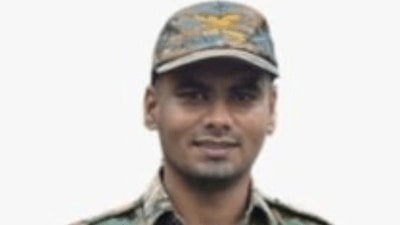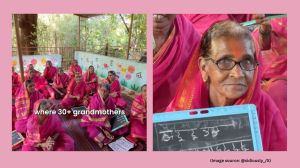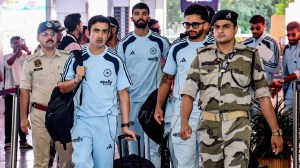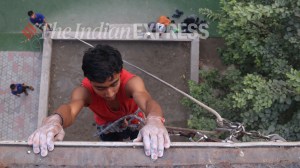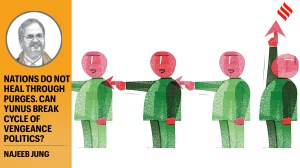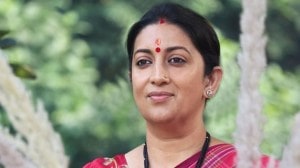Why Ayodhya isn’t hot anymore? Ask the men who stoned Babri
At 16 he was a kar sewak, a sort of Hindu commando wannabe. As the mob gathered outside Babri Masjid, Rangesh Acharya cheered himself hoarse...

At 16 he was a kar sewak, a sort of Hindu commando wannabe. As the mob gathered outside Babri Masjid, Rangesh Acharya cheered himself hoarse and hurled stones at the structure. ‘‘I couldn’t do more. Demolition was an expert job,’’ he recalls.
More than 11 years have passed and Rangesh is a different person, while at least some parts of his city are unrecogniseable from December 6, 1992, when he stood outside the mosque armed with stones.
November 19, 2003 was no ordinary day. In the surest sign that at least some people from this once-torn city were willing to start afresh, Mahant Gyan Das, the deputy head of Hanuman Garhi, organised an Iftar for the city’s Muslims. In turn, he was invited for Id Milan on November 29, 2003, where he and his disciples chanted Hanuman Chaalisa.
It is this face of Ayodhya that Rangesh and his friend, 29-year-old Veru Tiwari, another former kar sewak, are trying to promote. And it is in the efforts of organisations like theirs — Ayodhya ki Awaaz — that you find a reflection of why the Ram Temple is no longer an election issue.
Welcome to a pilgrimage — not a VHP conducted-tour — of Ayodhya. We head towards Hanuman Garhi. Rangesh and Veeru are our guides and they are in a reflective mood.
‘‘Spending a few days with VHP people can hypnotise you,’’ says Veeru, as he tries to explain 1992. ‘‘There was no reasoning. We were wild, mad and in rage.’’
The passing years stilled the rage and sowed doubts about the leadership they had followed blindly. In 2003, after a chance meting with Magsaysay Award winner Sandeep Pandey, they were convinced that Ram had been politicised.
Both of them started fasting in protest. Ironically, this landed them in jail on charges of sedition and inciting strife between religious communities.
‘‘In the seven days that we spent in jail, we realised that we should speak out. Ayodhya ki Aawaz was formed in jail,’’ says Rangesh. At least ten other former kar sewaks joined them as they walked out. Soon, the membership grew to 35. The process of healing and reaching out had begun.
It is 7 pm at Hanuman Garhi and the head priest is at the altar. Thousands of cymbals resound while a bulky policeman with a rifle blocks a view of the deity. ‘‘Twenty years ago, there was no need for the police here,’’ recalls an elderly worshipper.
Mahant Madhav Das has performed his puja and is riding away on his 100-cc bike. He is also a member of the Ayodhya municipality, from the Ram Janambhoomi ward and a member of Awaaz. ‘‘Telling people to take weapons to build a temple is against Hinduism,’’ he says.
Meanwhile, Mahant Nagaraj Sharan, 20, the newly-appointed head of a rich math believes that the temple should be built at the site — but without VHP and the votes clouding the issue. Temple bells grow softer. Among the flags on the shrines, those of BJP and the Congress have made their way. Meanwhile, rumblings against the VHP, once unheard of, have become louder.
The next morning, past the Sundar Bhawan temple, which was managed by a Muslim until as recently as 1995, we reach a small Muslim mohalla. The disputed site is close by. Only Hindus can enter it for a darshan of Ram Lalla.
Here we meet young Naushad, who has not been able to find a bride. ‘‘Nobody wants to send their daughter to Ayodhya,’’ he explains. ‘‘They are afraid of riots.’’ But Naushad joins us as we go in search of a wandering Hindu sadhu who recently sang in this locality at the Shahdath Nama — the remembrance of Imam Hussain.
Nauushad knows the words. ‘‘Payega payega jannath mein ghar payega, ishq rishalat ke dariya mein doob ke jo mar jayega.’’ Translated, this means: ‘‘Those who drown in love will reach the shore of the other world.’’
The sadhu’s hut is empty. But his voice has been added to other voices, now heard in Ayodhya, that speak of healing.





- 01
- 02
- 03
- 04
- 05


